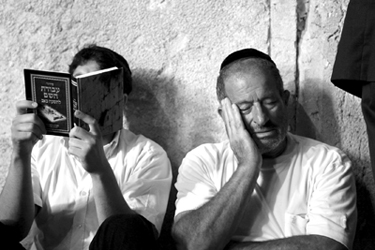By MOSHE GIT
As my years of involvement with Jewish tradition progress, I find myself time and again having the urge to emulate the little boy in Hans Christian Andersen’s story “The Emperor’s New Clothes.” The boy breaks from the common self-deception that the emperor is dressed nicely and cries out the truth: “The emperor is naked.”
At the end of the Pesach seder we declare, “Next year in Jerusalem.” This wish was pertinent in the past, when Jews couldn’t move freely to the Holy Land; but since Israel has become an independent state — and certainly since the 1967 Six-Day War, when Jerusalem’s Old City was recaptured — all that a Jew who craves to live in Jerusalem has to do is to purchase a plane ticket and go there. He doesn’t even have to wait until “next year.”
The more daunting example is the Nachem prayer recited on Tisha B’Av. That prayer purports to describe present-day Jerusalem as a city that is “mournful without her children,” “ruined without her abodes” and “desolate without inhabitants.” Several hundred thousand Jews presently live in Jerusalem, probably more than at any time in history. How can one recite this prayer today with a straight face? Even the pious Jews of today’s Jerusalem, including the multitude who live in its biblical quarters, continue to recite it.

Perhaps to the above list one may add the Kiddush Halevana (the moon sanctification prayer) recited monthly after the observance of a new moon. In that prayer one says: “Just as I dance toward you but cannot touch you, so may none of my enemies be able to touch me for evil.” I seriously doubt if those who drafted this sentence would have done so had they known that some day the moon would become touchable. Would they address a mountain some miles away that was visible but difficult to get to, thereby not readily touchable, in the same manner? I doubt it.
It is also doubtful that Maimonides would have kept his cool had he heard of the above customs. In Israel, where winters are rainy while summers are dry, a prayer for rain is added to the daily services during winter months. Usually, communities outside of Israel follow suit and recite the rain prayer during Israeli winters.
Maimonides, in his commentary to Trachtate Taanit, scorns those who ask for rain in locations or during seasons where rain isn’t expected, and calls this activity of theirs sheker and yivelet (a lie and stupidity). Would he not apply the same diagnosis to the phrases cited above?
There are other areas in which there is, seemingly, dissonance between Jewish practices and reality — the conformity of the Hebrew calendar to the solar seasons, for example. Judaism requires that Passover always occur in the spring. However, the Hebrew calendar is basically lunar, where months are shorter than those in the commonly used Gregorian calendar. For this reason, during a cycle of 19 years, seven times a correction is introduced in the form of adding a 13th month to the year.
The details were worked out by sages of yore. It was found more recently, scientifically, that the traditional rabbinical corrections were imprecise and insufficient; if no new correction is introduced, the Passover holiday will find itself in the summer season. Many pious Jews scoff at the scientific findings, and regard the traditional corrections as ordained by heaven and hold fast to them.
And then there is the biggie: the issue of the age of the world. It is difficult to reconcile the Jewish view that creation occurred merely 6,000 years ago with numerous findings, from many scientific disciplines, that the earth is billions of years old. A full discussion of this issue requires another article. I will only comment here that there is a tendency to attempt to resolve the difficulty by belittling the scientific findings. This appears to me like burying one’s head in the sand.
Perhaps it is appropriate to introduce here a word of caution by again quoting Maimonides, who held that “where the opinion of our sages is contradicted by proven evidence from nature, one has to disregard the opinion of the sages” (from the introduction to the book by Zvi Hirsch Yaffe, the grandson of Baal Halevushim, Mordechai Yaffe, 1931).
A poignant example of the tendency to accord supremacy to rabbinic practices over scientific findings is the fact that many smokers from ultra-Orthodox circles argue that smoking is okay, since many a rabbinic luminary smoked or smokes now. They believe that rabbinic luminaries are close to heaven and, therefore, know better than any scientist that smoking is benign.
***
Moshe Git lives in Minnetonka.




















